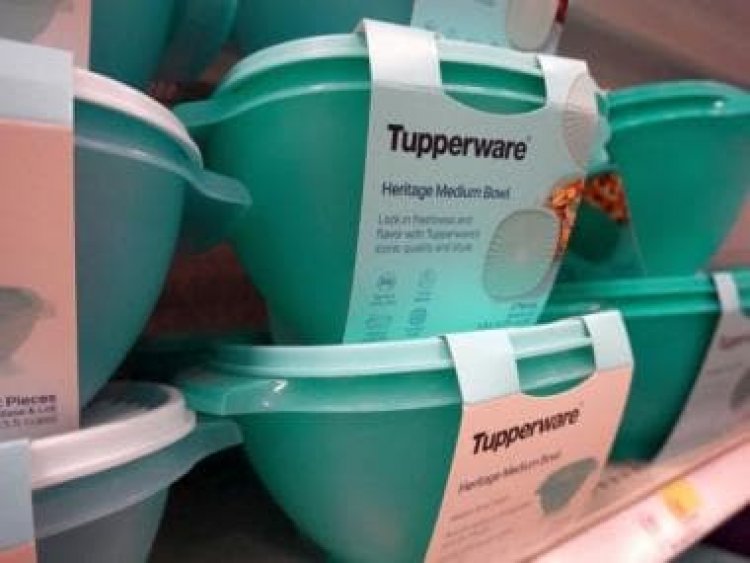Toodles to Tupperware: Why the household brand could be going out of business soon
Toodles to Tupperware: Why the household brand could be going out of business soon

A peek into any kitchen across the world would reveal a Tupperware box. However, soon the storage containers deemed a necessity will no longer appear in kitchens across the world.
It appears that cracks have emerged in the once revolutionary air-tight sealing business and with falling sales and rising debts, the US-based company may soon go under.
Let’s take a look at the history of the brand which was once synonymous with food storage and what is ailing it now.
The rise of Tupperware
Today, Tupperware containers are synonymous with the kitchen. However, its inception was on the battlefield. Chemist Earl Tupper had a spark of inspiration while creating moulds at a plastics factory. He believed that if he could design an airtight seal for plastic storage containers, like those on a paint can, he could help war-weary families save money on costly food waste. And with that in 1946, the world saw the birth of Tupperware products.
When these containers hit the market, TIME magazine raved about the plastic, saying it could “withstand almost anything,” and House Beautiful marvelled at the simplistic, yet chic, design. From then on, it spread like wildfire and the Orlando-based company became the standard for all kitchen boxes.
In the 1950s and ’60s, the ‘Tupperware parties’ helped make the boxes an iconic and its air-tight and water-tight containers took the market by storm.

But it wasn’t just the airtight boxes that helped set Tupperware apart from the run of the mill containers. The US company’s core business model of using self-employed salespeople, who sell from their own houses, helped in making Tupperware the brand it is today.
And just how iconic did the brand become as the years passed by? “We use it (Tupperware) as a noun, which is quite unusual for a brand,” Catherine Shuttleworth, founder of retail analysis firm Savvy Marketing, tells BBC. “I think a lot of younger people will be surprised it is a brand in itself.”
So famous was the brand that it is sold in 100 countries across the world. And at its peak, it was reported that every 1.5 seconds, somewhere on the planet, a Tupperware party was thrown and it sold over $2.6 billion (Rs 21, 345 crore) worth of product.
The fall of Tupperware
On Monday, the shares of the 77-year-old US company tanked by 50 per cent after it announced that there was “substantial doubt about the company’s ability to continue as a going concern,” and that it was working with financial advisers to find financing to stay afloat.
It added that it didn’t have enough cash to fund its operations if it didn’t secure additional investment. Moreover, the company was exploring layoffs and was reviewing its real estate portfolio for potential money-saving efforts.
The New York Stock Exchange also warned that the company’s stock was in danger of being delisted for not filing the required annual report.

CEO Miguel Fernandez reacting to the news said in a statement, “The company is doing everything in its power to mitigate the impacts of recent events, and we are taking immediate action to seek additional financing and address our financial position.”
But what went so wrong for the storage containers business? A lot has to do with the industry itself. When Tupperware entered the market, it was perhaps the only company to provide airtight containers. But, today, there’s countless options to choose from and that too at a cheaper price than Tupperware.
And this reflects in its sales. Sales have steadily fallen the past couple of years. This freefall was arrested during the COVID-19 pandemic when people stayed home and cooked and baked for themselves, but this relief was shortlived. From having sales of nearly $500 million (Rs 4,104 crore) in the fourth quarter of 2020, the company reflected just $313 million (Rs 2,568 crore) in its most recent fourth quarter.
There’s also the heavy criticism against plastic. Studies have shown that Phthalates, which are used to make plastic more flexible and are found in food packaging and plastic wrap, have been found in measurable levels across the US population. They have been linked to reproductive dysfunction in animal studies and some researchers have suggested links to decreased fertility, neuro-developmental issues and asthma in humans.
Also read: How traces of microplastics were found in breast milk
There’s also the worry of BPA — another chemical widely added to food plastics. This has been found to be harmful to the human body.
Another reason for the fall in Tupperware sales can be attributed to the distribution model itself. In this digital age, the face-to-face model doesn’t hold relevance.
Neil Saunders, managing director of retail at the consultancy GlobalData, was quoted as telling the BBC that Tupperware had “failed to change with the times” in terms of its products and distribution, highlighting that the method of selling direct through its parties “was not connecting” with either young or older customers.
Realising this, the company, did diversify last year when it signed a deal with US mega chain Target to sell its products in-store. But it’s almost a case of too little too late.
In fact, Saunders in the BBC report adds that if Tupperware had made bigger changes 10 years ago, the firm might have be in a different position now.
With inputs from agencies
Read all the Latest News, Trending News, Cricket News, Bollywood News,
India News and Entertainment News here. Follow us on Facebook, Twitter and Instagram.
What's Your Reaction?



























































